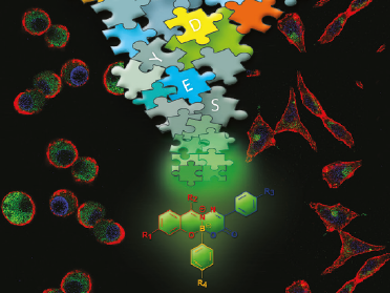Dyes for Fluorescence Studies
Functional dyes for imaging sensing and probing are a common goal for multidisciplinary teams and a flexible and modular approach could be the most fruitful. Now, an international team based in Finland, Portugal, and Spain has turned to BASHY, boronic acid salicylidenehydrazone, as the starting point for a modular fluorophore platform.
Previously, rhodamine, fluoroscein, oxazine, coumarin, and cyanine, have been the “go to” dyes for fluorescence studies. Moreover, boron dipyrromethene (BODIPY) has been the focus of various successful developments. Nevertheless, the widely available and diverse boronic acids have not been studied much in this field despite their great potential.
Boron Acids
Pedro Gois of Faculty of Pharmacy, University of Lisbon, Uwe Pischel from the University of Huelva, and colleagues at these two institutions and at the Tampere University of Technology, writing in Chemistry – A European Journal, suggest that the reason for this might be that others have found them to be dim fluorophores or that they prove to be difficult to assemble into useful fluorescent entities. The team proposes, however, that “BAs offer attractive opportunities for the discovery of fluorescent supramolecular architectures, since this function may be used to rigidify unreported structures of tridentate π-conjugated ligands, which can be further tuned, depending on the BA structure.”
Now, they explain how they have developed an approach to assemble boronic acids in a modular fashion using Schiff-base ligands to give them a new range of what they refer to as innovative fluorescent dyes. These compounds, prepared in up to 99 % yield, are not only stable to light but structurally diverse, which opens up a wide range of different applications. The dyes fluoresce very brightly and display a polarity-sensitive green-to-yellow emission with high quantum yields of up to 0.6 in non-polar environments, the team reports.
Useful in Studies of Living Tissues
The team was also able to fashion highly fluorescent poly(lactide-co-glycolide) nanoparticles from these dyes that are both stable and non-cytotoxic, which means they could be useful in studies of living tissues. Indeed, tests on HeLa cells revealed that these fluorescent compounds can selectively stain lipid droplets of these important laboratory cells without killing the cells and without interfering with other labeling compounds used to image the cell membrane at the same time.
This is, the researchers conclude, the demonstration that boronic acids are very useful building blocks to prepare structurally diverse fluorophores. It represents a simple synthesis that sidesteps complex chromatographic separation. “The development of new live-cell imaging methodologies is vital to foster new research in cell biology,” the team told ChemViews magazine. “Therefore, we envision that this BASHY platform will emerge as a powerful tool for the tailored design of fluorescent dyes for advanced bioimaging applications.”
- A Three-Component Assembly Promoted by Boronic Acids Delivers a Modular Fluorophore Platform (BASHY Dyes),
Fbio M. F. Santos, João N. Rosa, Nuno R. Candeias, Ctia Parente Carvalho, Ana I. Matos, Ana E. Ventura, Helena F. Florindo, Liana C. Silva,[a] Uwe Pischel, Pedro M. P. Gois,
Chem. Europ. J. 2016.
DOI: 10.1002/chem.201503943




